#pétrus borel
Text
Sanson: I'm not doing it.
Passereau:

6 notes
·
View notes
Text

This is… (besides everyone remarking on how unnecessarily violent and vicious Janin’s review is) simply being bad at your job… Since Sade has a cameo in Borel’s book it’s like threatening to mention something the author has already put into his work :p
#pétrus borel#i mean that reply reads like sang froid#but there must have been a bit of are you kidding me in there as well#also interesting that borel asked for the review himself#which emboldened janin bc he imagined borel wouldn’t sue him#that’s twisted#(also)#(and this is stuff for another post)#i keep finding info about balzac and borel#there’s a satirical sketch by borel in the source#but there’s more#I’m trying to understand why the latest lost illusions movie included borel’s le corsaire+le satan in it xD#bc it seems very random#and it’s not in the novel#iirc
0 notes
Text
Bousingo Fashion: Rash Waistcoats and Scarlet Opinions
something of a companion piece to my recent post on Romantic fashions, dealing with a subset of it --specifically, the Bousingo style, or. What Would Bahorel Wear?
( @badassindistress, this is for you XD)
First, for those who’ve missed my other rambles on the Bousingo/Bouzingo/Bousingots group, a quick description of their general Deal, from Jehan Valter’s account of the premiere of Hugo’s le roi s’amuse:
No doubt, the Bousingots had fought at Hernani and broke their share of seats, but ...The Bosingouts alone were at the barricades of 1832. There is the difference between them and the Jeune-France,... while the Young-France, inspired by the Byronnian sadnesses, hid their health and their good humor under elegiac and morbid exteriors, while they were satisfied with the freedom of the enjambement, and that they dreamed of revolutions as those of art, the Bousingots manifested political sentiments of extreme violence at least in form.
There’s a LOT of room to debate this description, but it gets across the general contemporary view of the group: the street-fighters types of Romantic republicanism, or of Republican romanticism; whichever side of it you like to emphasize. The stereotype of their character was...well, Bahorel,pretty much to the letter. Hugo knew what he was writing, down to the Rash Waistcoats. Bahorel dresses Bousingo! which means a very identifiable and politically loaded style But what exactly did that look like?
Let’s get some more 19C quotes in here!
" ...(there was) Pétrus Borel, in “bousingot” costume of insulting originality*: Marat* waistcoat, and a pointed hat with long ribbons, descending in the middle of the back.." (Jehan Valter's account of the opening night of le Roi s'amuse)
He could be spotted from afar by his pointy, wide-brimmed grey hat, his goatee, his long hair, by his enormous red cravat that clashed with the white lapels of his Marat-style waistcoat...- George Sand, Horace
There’s already a lot going on here, but let’s start with:
Rash Waistcoats
...the best fellow possible; he had rash waistcoats, and scarlet opinions... (LM 3.4.1)
So as far as I’ve been able to tell, a Marat waistcoat is a waistcoat with really, REALLY Extra lapels. Based on , of course, Marat, as seen in this image:
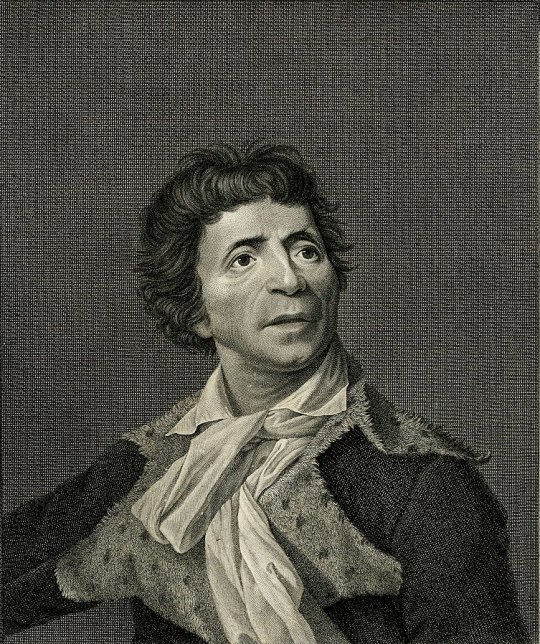
(ID: noted French revolutionary Marat wearing an extravagantly loose cravat, and a furry...jacket? with wide, spotted lapels. Very Wide. Almost sticking out further than his arms. He’s gonna put someone’s eye out with those things./end ID)
I *think* those are coat lapels--but the waistcoat named after him seems to be based on that look. Lapels for days!
(note: a “Robespierre” waistcoat, like Grantaire wears, seems to be the same idea- a waistcoat with wide lapels--but not as exaggerated, and with a different cut. Like so :

(ID: a bright red waistcoat with lapels that reach almost to the arm-scye /end ID)
And you can read more about them at this excellent post! )
George Sand’s Bouzingot wears a white Marat waistcoat,but red was a more iconic color. And a very specific red! Let’s fire up the quotes again!
" In order to avoid wearing the infamous red of '93, I had admitted a slight admixture of purple into the dye, for I was very desirous not to be suspected of any political intention. I was not an admirer of Saint-Just and Maximilian Robespierre, as were some of my comrades..." -Theophile Gautier, A History of Romanticism
The “infamous red” to avoid was scarlet, the color Bahorel definitely wears:
Bahorel, who was like a fish in water in a riot...wore a scarlet waistcoat, and indulged in the sort of words which break everything. His waistcoat astounded a passer-by, who cried in bewilderment:--
"Here are the reds!"
The Beards
“It was my beard that saved us! my romantic beard! my pretty little romantic beard!"- Les Miserables, 3.8.12
A beard ,fine,silky,full,scented with benzoin,and cared for as a Sultan's beard might be,... A beard ! A very ordinary matter in France nowadays,but at that time there were but two in the country : Eugène Devéria's and Petrus Borel's . It required absolutely heroic self - possession and contempt of the multitude And mark that when I say beard , I do not mean mutton-chop or fin-shaped whiskers,or a tip or a tuft,but a genuine,full,complete beard,one to make a man shudder . -Theophile Gautier, A History of Romanticism
In the 1820s and 1830s (especially early 1830s) beards were incredibly Out. Men of Proper Society simply Did Not Wear Them, Oh, they had facial hair--but not beards.
I need you all to understand how silly this dividing line got, so I made a Diagram:
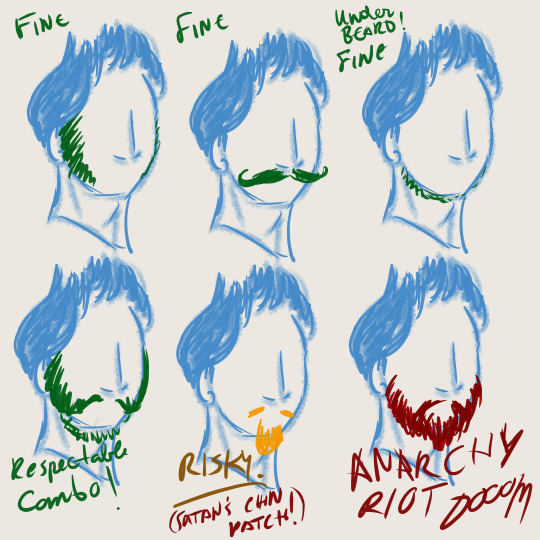
(ID: a rough sketch of a face, showing, in order, sideburns, a moustache, a neckbeard, and all three combined; these are in green and labeled “fine”. one face has a small soulpatch-level goatee, labeled “Risky, Satan’s Chin Patch”. The last shows a short but fully connected beard, with facial hair covering the entire jawline, labeled “Anarchy, Riot, Doom” /End ID)
The Full Beard was Iconically Romantic and especially iconically Bouzingo Romantic, as you’ll see when we hit the caricatures. Oh boy, are there gonna be caricatures.
The final part of this is the hat--and here, I think, it’s time to move into contemporary (and near-contemporary) illustrations. First , a fairly Subdued version of two Bouzingo meeting:

(ID: two Bouzingo talking closely, with a Secret Handshake. They are wearing the clothes described in this post. Behind them a policeman gestures angrily. /end ID)
I love this picture (and would love to know the provenance!) ! You can see the Marat waistcoat lapels, the beard on the one on the left, and, of course, the signature Pointy Hat. Imagine those lapels in bright scarlet, those trousers in plaids, black, or white, and the jackets in either bright blue or dark black for maximum waistcoat contrast, and you’ve got a good mental image of how this would have looked at the time.
...You can also see the police officer telling them to move along. “Hostile Police Interaction”is also an iconic part of the Bousingo look, for obvious reasons.
Here are some more fairly realistic, and sympathetic, pictures; these are illustrations of Laraviniere, the “Bouzingo” character in George Sand’s Horace.
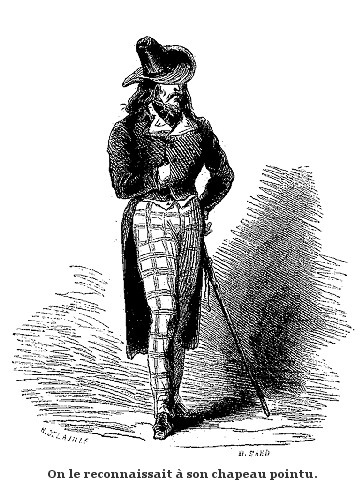
Beard, long hair, pointed hat, extravagant but loose cravat, “Robespierre” style lapels sticking out, tight plaid pants, solid cane for whomping people in fights? It’s the whole package baby!

I gotta include this picture too, because “naked , having grabbed a carpet, so you can come out and fight with landlords and cops” is also an Iconic Bouzingo Look. I am extremely not joking. If you’re going to care at all about propriety , you can’t be Bousingo, and at least one group (and that led by Borel, Bahorel’s most direct inspiration) did run a nudist commune for a while!
These images are reasonably realistic,even sympathetic, portrayals. Now let’s get to the caricatures, and how people who didn’t like them saw all this. This is some of my favorite stuff, it’s hilarious:

Image: Caricature (un peu chargée) d’un “bousingot” romantique
This image, leaning heavily on the Romantic associations of the Bouzingo, brings in that Medieval-style dress I mentioned. Apart from the hat and beard, this guy doesn’t have anything particularly Bousingot about his outfit; the dramatic ruff and doublet-esque cut of his coat could go for any Romantic. But I love this picture , look how ticked off he looks!XD
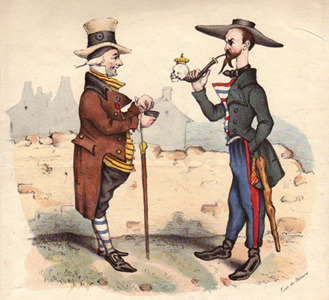
I have no idea if this illo, titled “Old and New”, was supposed to be insulting, but I think it’s really charming! It’s a French Revolution-era revolutionary-- Robespierre-striped coat, knee breeches, wig or powedered hair, little cockades, etc,-- meeting a then-”new” Bouzingo, in striped trousers, a broad-lapeled tricolor waistcoat, a wide-brimmed “sombrero” type hat (also a solid Bouzingo fashion choice) , full beard (but super short hair--the other way that fashion ran,it’s either long or basically a canon-level buzzcut), and 1830s coat. The old Revolutionary carries a neat cane, and appears to be opening a snuffbox; the Bouzingo carries a fightin’ stick, and appears to be smoking a pipe made with a crowned skull holy shit I love it. And they’re getting along just fine! I have no idea if the vibe is supposed to be “The kids are all right! carrying on the banner!” or “ Look,the Youth of Today is trying to bring back that awful Revolution!” but either way the affinity between generations has me charmed. (and again, we see the strong perceived political aspect to Bouzingo fashion!)
Now a couple of definitely unflattering images:

Above, from an article about “newspapers and their readers”: a Bouzingo reads Le Charivari! as @clove-pinks said on the post that introduced me to this image: “Swanky, obnoxious outfit, long hair, reading Le Charivari illustrated magazine—it’s a bousingot Romantic! “
Again we’ve got the hat, the beard, the loud pants, the stick (I am dying at the stick placement omgggg) -- but you can see how the negative take on them frames them as poor (everything here is patched and broken) , dirty, and menacing.
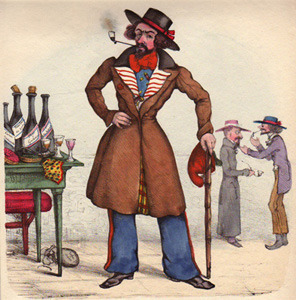
One more, from the same source as “Old and New”: a whole darn group! Again, there’s the outfit geared to be provocatively tricolor, the broad sombrero style hats, a friggin Phrygian cap, a heavy stick , and beards all around. Note though the wide array of colors, especially the guy in a pink hat in the background!:D
So there’s Bouzingo/Bozingo/Bousingo etc fashion for you! Right at the intersection of Aggressively Political and Dramatically Romantic, bright, brash-- but still leaning into (then) modern styles. This look was about knowing the modern dress code enough to send very clear and specific messages; in this case, “Ready, willing, and able to throw down for the republic at any moment”. It could be toned up or down , but it was always LOUD (Bouzingo Means Noise!!) and it was meant to be a legible message to anyone who’d been in Paris for five minutes. Anyone wearing this outfit (a) knows how to do Style, and they’ve chosen to wear this look , and (b) is a fighter, or is about to become one, because oh,you will get punched in this outfit. Or arrested. Or punched and then arrested.
But you’re gonna look incredible when it happens.
#Bousingot#Bouzingo Bouzingot Bousingo#Bahorel relevant#yeah it can go in the#Bahorel#tag#there is SO MUCH MORE i could say#but this is . 1700 words help#long post#canon era fashion
66 notes
·
View notes
Text
.... sous mes pieds fuit la terre :
Je ne suis plus qu'un son! un reflet! un mystère
Pétrus Borel
8 notes
·
View notes
Text

PETRUS BOREL
BOREL PIERRE-JOSEPH D' HAUTERIVE dit PÉTRUS (1809-1859)
Champavert, contes immoraux. Paris, Eugène Renduel, 1833. In-8, maroquin rouge, triple filet, dos orné, dentelle intérieure, tranches dorées sur marbrure (Canape).
Très rare édition originale de cet ouvrage recherché. Ce recueil de 6 nouvelles truculentes, horribles et cruelles est l’une des oeuvres les plus typiques de l'esprit du « Lycanthrope ».
"La pluie tombait à flots, le tonnerre mugissait, et quand les éclairs jetaient leurs nappes de flammes sur la plaine, on distinguait Flava, échevelée ; sa robe blanche semblait un linceul, elle était couchée sous les touffes du houx. Champavert, à deux genoux sur terre, de ses ongles et de son poignard fouillait le sable. Tout à coup, il se redressa tenant au poing un squelette chargé de lambeaux : — Flava ! Flava ! criait-il, tiens, tiens, regarde donc ton fils ; tiens, voilà ce qu’est l’éternité !… Regarde !"
Chef de file de ceux que l'on désigne communément du nom de « petits romantiques français », boudé par le succès de son vivant, Pétrus Borel s'impose aujourd'hui comme l'un des écrivains les plus originaux du romantisme.
bibliorare.com
3 notes
·
View notes
Text
Pétrus Borel dit « le lycanthrope », né à Lyon le 29 juin 18091,2 et mort à Mostaganem (Algérie) le 17 juillet 18591, est un poète, traducteur et écrivain français.
I have to respect this Wiki article for 1) bringing up the werewolf thing right off the bat, and 2) being in present tense, which has terrifying implications about Borel’s longevity.
#yes I know most if not all FRWiki articles are in present tense. it's still concerning!#Pétrus Borel#jeunes france#Romantisme frénétique#French tag#shoelace fandom
26 notes
·
View notes
Quote
Il faut qu'un enfant jette sa bave avant de parler franc; il faut que le poète jette la sienne, j'ai jeté la mienne : la voici ! ... Il faut que le métal bouillonnant dans le creuset rejette sa scorie; la poésie bouillonnant dans ma poitrine a rejeté la sienne : la voici ! ...
Pétrus Borel
11 notes
·
View notes
Text
why does this drawing of Pétrus Borel look like a mugshot????

16 notes
·
View notes
Text
It’s almost Yuletide! This will be my 18th Yuletide! My first Yuletide story will be old enough to vote this year and I have some mixed feelings about that! But also I have never missed or defaulted on a Yuletide since, and I have to say I feel pretty proud of that.
I am still pretty far down the Les Misérables rabbit hole (speaking of which, it is not too late to propose programming for Barricades!), and unsurprisingly all the fandoms I'm nominating/requesting this year are set in July Monarchy France--Les Mis canon era: Petit-Cénacle RPF,
Champavert: Contes Cruelles | Champavert: Immoral Tales - Pétrus Borel, and Les Enfants du Paradis | Children of Paradise.
Petit-Cénacle RPF
The Petit-Cénacle was a French Romantic salon, slightly younger and considerably more politically radical than the Cénacle centered on Hugo and Dumas; it included painters and sculptors as well as writers and critics, and most of its members at least dabbled in both written and visual arts. Its best-known members today are Théophile Gautier, Gérard de Nerval, and Pétrus Borel (the Lycanthrope)--the last two are thinly fictionalized in Les Misérables as Jean Prouvaire and Bahorel. (It's debatable how much Grantaire owes to Gautier but it's probably a nonzero amount.)
The group coalesced around Borel and Nerval as the organizers of the Battle of Hernani--a fight between Romantics and classicists at the premiere of Victor Hugo's play Hernani in 1830. Most theater productions at this time had claques--groups of paid supporters of a show or an actor, who were planted in the audience to drum up applause. For Hernani--the first Romantic work staged at the prestigious Comédie-Français, which broke classical norms so thoroughly that it no longer seems at all transgressive--Hugo and the theater management decided they were going to need more than just a claque. They recruited a few of Hugo's fans--Gautier was so star-struck he had to be physically hauled up the stairs to Hugo's apartment--to stage An Event. The fans recruited their friends. They showed up in cosplay, with the play already memorized and callback lines devised. It was basically the Rocky Horror Picture Show of its day. It almost immediately turned into an actual fight, with fists and projectiles flying. And it made Hernani the hottest ticket in Paris.
This is the group's origin story, and they pretty much spent their lives living up to it. They were every bit as extra as you would expect--Nerval allegedly walked a lobster on a leash in the Champs-Elyseés, explaining that "it knows the secrets of the deep, and it does not bark"--but they also stayed friends all their lives, often living together, supporting each other through poverty and mental illness and absurd political upheaval.
I'm nominating Pétrus Borel | Le Lycanthrope, Théophile Gautier, Gérard de Nerval, and Philothée O’Neddy; you could nominate other people like Jehan Duseigneur, Celestin Nanteuil, or the Deverias, or associates of the group like Dumas and Hugo.
The Canon
Gautier's History of Romanticism covers the early days of the group and the Battle of Hernani in some detail. (There is also a 2002 French TV movie, La bataille d'Hernani, which is charming and pretty accurate; hit me up if you want a copy.)
Other than that--this crowd wrote a lot, and they're all very present in their work--even in their fiction, which is shockingly modern in a ton of ways.
For Gautier, Mademoiselle de Maupin has a lot of genderfeels, surprisingly literal landscape porn, and a fursuit sex scene in chapter two.
If you want Nerval's works in English, you might be limited to dead-tree versions, but I highly, highly recommend The Salt Smugglers, a work of metafiction that answers the question, "What if The Princess Bride had been written in 1850 specifically to troll the press censorship laws of Prince President Louis-Napoleon Bonaparte?"
Borel's experimental short story collection Champavert has a new and very good English translation by Brian Stableford and is also my next fandom :D.
Champavert: Contes Immoraux | Champavert: Immoral Tales - Pétrus Borel
Last year I requested Borel RPF but I decided this book was unfanficcable. This year, I am going to have a little more faith in the Yuletide community.
Champavert, available in ebook and dead tree form, is a weird as hell little book and probably the best thing I read last year. It's an experimental short story collection from 1830. Someone on one of my Les Mis Discords described it as "a collection of gothic creepypasta, but the author is constantly clanging pots and pans together and going 'JUST IN CASE you didn't notice, the real horror was colonialism and misogyny all along and i'm very angry about it!'"
And, yeah, pretty much that, with added metafictional weirdness, intense nerding about architecture and regional languages, and the absolute delight that is Borel's righteously ebullient voice.
Borel wrote for a couple of years under the name of The Lycanthrope, and though he kills the alter ego in this book, the name stuck, and would continue to be used by friends and enemies alike all his life. Pretty much everyone who met Pétrus agreed that 1) he was just ungodly hot; 2) he was probably a werewolf, sure, that makes sense; and 3) he was definitely older than he claimed to be, possibly by centuries, possibly just immortal, who knows.
But, like I said, he kills the alter ego in this book: it begins with an introduction announcing that "Pétrus Borel" has been a pseudonym all along, that the Lycanthrope's real name is Champavert--and that the Lycanthrope is dead and these are his posthumous papers, compiled by an unnamed editor; the papers include some of Borel's actual poems and letters, published under his own name. The final story in the collection is called "Champavert, The Lycanthrope," and is situated as an autobiographical story, following a collection of fictional tales--which share thematic elements and, in the frame of the book, start to look like "Champavert"'s attempts to use fiction to come to terms with events of his own life.
And that's probably an oversimplification; this is a dense little book and it's doing a lot.
The subtitle is Contes Immoraux. It's part of a genre of "contes cruelles" (and, content note for. Um. A lot), but it's never gratuitously cruel--it's very consciously interrogating the idea of the moral story, and what sort of morality is encoded in fables, and what it means to set a story where people get what they deserve in an unjust world where that's rarely the case.
I'm nominating the unnamed editor, Champavert, his friend Jean-Louis from the introduction and the final story, and Flava from the final story; you could also nominate characters from the explicitly fictional stories.
Les Enfants du Paradis | Children of Paradise
This is a film made between 1943 and 1945 in Vichy and Occupied France and set...somewhere?...around the July Revolution, probably, I'll get into that :D. There's a DVD in print from Criterion and quite possibly available through your local library system. (And it's streaming on Amazon Prime and the Criterion Channel.)
It's beautifully filmed, with gorgeous sets and costumes and a truly unbelievable number of extras, and some fantastic pantomime scenes. (On stage and off; there's a scene where a henchman attempts to publicly humiliate a mime, and it goes about as well as you would expect.)
"Paradise," in the title, is the equivalent of "the gods" in English--the cheap seats in the topmost tier of a theater. It's set in and around the theaters of the Boulevard du Temple--the area called the Boulevard du Crime, not for the pickpockets outside the theaters but for the content of the melodramas inside them.
The story follows a woman called Garance, after the flower (red madder), a grisette turned artists' model turned sideshow girl turned actress turned courtesan, and four men who love her, some of whom she loves, all of whom ultimately fail to connect with her in the way she needs or wants or can live with.
This sounds like a setup for some slut-shaming garbage. It's not--Garance is a person, with interiority, and the story never blames her for what other people project onto her.
Of those four men, one is a fictional count and the other three are heavily fictionalized real people: the actor Frédérick Lemaître, the mime Baptiste Deburau, and the celebrity criminal Lacenaire. Everyone in this story is performing for an audience, pretty much constantly, onstage or off: reflexively, or deliberately, or compulsively.
Garance's survival skill is to reflect back to people what they want to see of themselves. She never lies, but she shows very different parts of herself to different people. We get the impression that there are aspects of herself she doesn't have much access to without someone else to show them to. Fréd��rick is also a mirror, in a way that makes him and Garance good as friends and terrible as lovers--an empty hall of mirrors. He's always playing a part--the libertine, the artist, the lover--and mining his actual life and emotions for the sake of his art. Baptiste channels his life into his art as well, but without any deliberation or artifice--everything goes into the character, unfiltered. It makes him a better artist than any of the others will ever be, but his lack of self-awareness is terrifying, and his transparency fascinates Garance and Frédérick, who are more themselves with him than with anyone else. Lacenaire, the playwright turned thief and murderer, seems to no self at all, except when other people are watching. Against the performers are the spectators: the gaze of others--fashion, etiquette, and reputation--personified by Count Mornay; and the internal gaze personified in Nathalie, an actress and Baptiste's eventual wife, who hopes that if they observe the forms of devotion for long enough the feeling will follow.
The time frame is deliberately vague--it's set an idealized July Monarchy where all these people were simultaneously at the most exciting part of their careers. In the real world, Frédérick turned his performance of Robert Macaire into burlesque in 1823, Baptiste's tragic pantomime Le Marrrchand d’Habits! ("The Old-Clothes Seller") played in 1842, and Lacenaire's final murder, for which he is guillotined, is 1832; these all take place in Act II of the movie within about a week of each other.
(Théophile Gautier, mentioned but tragically offstage in the film, was a fan of Baptiste; Le Marrrchand d’Habits! started as Gautier's fanfic--he wrote a fake review of a nonexistent pantomime, and the review became popular enough the Theater des Funambules decided to actually stage it. It only ran for seven performances.)
I am nominating Garance, Frédérick Lemaître, Baptiste Deburau, and Pierre François Lacenaire. You could nominate any of the other characters (Count Mornay, Nathalie, the old-clothes seller Jéricho, Baptiste's father, his landlady, Nathalie's father the Funambules manager). Gautier, regrettably, does not actually appear in the film but you can bet that's going to be one of my prompts.
So, that's one good movie you definitely have time to watch before signups, several good books you probably have time for and that are probably not like whatever else you're reading right now, and one RPF rabbit hole to go down! Please consider taking up any or all of these so that you can write me fanfic about Romantic shenanigans.
#yuletide#crosspost from Dreamwidth#petit-cenacle#champavert#children of paradise#les enfants du paradis#petrus borel
5 notes
·
View notes
Text
Don Andrea Vesalius, el anatomista
Don Andrea Vesalius, el anatomista
Pétrus Borel
Una vez terminado este relato de Andrea Vesalius, fue llevado a la Revue de Parisy ofrecido al señor Amédée Pichot, como traducción del danés de un supuesto Isaïe Wagner; como su forma no convenía a esa revista literaria, el señor Amédée Pichot no pudo editarla; pero, como la presunta traducción estaba pagada, se sirvió del mismo héroe para bordar el delicioso cuento anatómico…
View On WordPress
0 notes
Text
Some hot takes in Thibaudet’s History of French Literature:
Battle of Hernani was fun and all, But Dumas was the better Romantic playwright
Balzac being a bad writer shouldn’t be a factor. We don’t come to him for perfectly crafted sentences and well rounded plots.
Borel’s Heirs fans are everywhere, yet nobody reads Pétrus Borel. Anyone who likes Baudelaire, Lautréamont or Jarry should at least spend an hour a day reading Borel
#french romantics#a very divulgation level text and not all his takes are of my taste#but it’s fun and handy to remember chronologies etc
8 notes
·
View notes
Text
apaladinagain
#he is literally not stupid!!!!#his priorities are different from societies and he is acting on that#in a logical and joyful way#every time we see him??#he's still at uni by choice because it's a great situation for organizing!! and also other forms of radical joy!#fuck off he is not stupid (affectionate) let alone any other kind#what he's got a type of brilliance that's disparaged by the cop in your head
artsymoth
#he's not stupid he just knows how to have fun
shadowofmoths
#he's literally not stupid.#hes very smart. AND wants to punch things.#rel contains multitudes okay?
pilferingapples
#show me where in the text Bahorel is stupid.#Show me where he's even a LITTLE stupid.#by god and anime I will argue this point forever#will this poll be our Denny's Parking Lot at 3am#I kinda feel like it SHOULD be#you know#for the vibes
shitpostingfromthebarricade
#Bahorel is actually hella smart#he just misuses abuses or very intentionally refuses to use his knowledge when he thinks it'll be fun or interesting#French Romanticism is such a fun and wild movement#also it requires p much every CW but if you ever wanma get more of a feel for Bahorel#Champavert by Pétrus Borel is SO good#like even its concept of ''immorality tales'' is like ... so good#but again: it has murder racism s/a suicide infidelity and injustice of all kinds#so if that is not something you think you're up for maybe it isn't the Borel book for you#(but also if it is get the translation by Brian Stableford)#(Brian is SO good with translating and footnotes and clearly just enjoys his job and the era and the authors he translates)#(and also apparently the other main translation is dogshit)#bahorel#also we don't ever get any canon indication that Bahorel is big or beefy#it says he is always down for a ruckus#but that doesn't mean a fist fight#it doesn't even mean he'll win#you know who was also always down to fight? pre-serum Steve Rogers#I maintain my HC of Fezzik!Jean Prouvaire and Inigo!Bahorel stature#but this to say that even if he was dumb (he's not) he doesn't even fit the other specifications!!!
everyonewasabird
#...#h#how is this a question#if hugo were smart enough to know what bahorel was talking about les mis would be a better book
hello squad solidarity XD
#special hello to Barri and Paladinagain#for channeling that whole cenacle spirit and going on a Digression <3<3<#<3#god I want my tablet back so I can do an Art of these responses#' is Bahorel a himbo' greatest thread in the LM fandom locked after etc
32 notes
·
View notes
Text
i get really frustrated when i can only find poems by pétrus borel in french by my french ISN´T GOOD ENOUGH
1 note
·
View note
Text
Bibliothèque de livres d'arts audio gratuits
Bibliothèque de livres d’arts audio gratuits
Notre bibliothèque de livres d’arts audio gratuits
Catégorie : Arts
AXA, Zo (d’) – Par l’image
BAUDELAIRE, Charles – Richard Wagner et Tannhäuser à Paris
BLAZE DE BURY, Henri – Mozart et la Flûte Enchantée
BOREL, Pétrus – L’Obélisque de Louqsor
BOVE, Emmanuel – Un peintre de l’aventure – Le Retour de l’enfant
CÉZANNE, Paul – Pensées sur la peinture
DIDEROT, Denis – Essai sur la peinture…
View On WordPress
0 notes
Text
Tal día como hoy, 30 de junio mostramos los natalicios y fallecimientos de los escritores más destacados:
1685 Nace John Gay, poeta y dramaturgo inglés
1803 Nace Thomas Lovell Beddoes, poeta y dramaturgo británico
1809 Nace Pétrus Borel, escritor francés
1884 Nace Georges Duhamel, escritor y poeta francés
1899 Muere E. D. E. N. Southworth, novelista estadounidense
1911 Nace Czesław Miłosz, escritor polaco, premio Nobel de literatura en 1980
1917 Nace Agustín Millares Sall, poeta español
1925 Nace Philippe Jaccottet, poeta francés
1932 Nace Mongo Beti, novelista camerunés
1939 Nace José Emilio Pacheco, literato mexicano
1949 Muere Jalil Mutran, poeta libanés
1959 Muere José Vasconcelos, abogado y escritor mexicano
1973 Muere Nancy Mitford, novelista inglesa
1984 Muere Lillian Hellman, dramaturga y novelista estadounidense
2016 Muere Geoffrey Hill, poeta inglés
0 notes
Link
Con Pétrus Borel, escritor antisistema… y hambriento, Champavert, Cuentos Inmorales, Rhapsodies, El gran sueño de Cheval, Palais Idéal,
0 notes